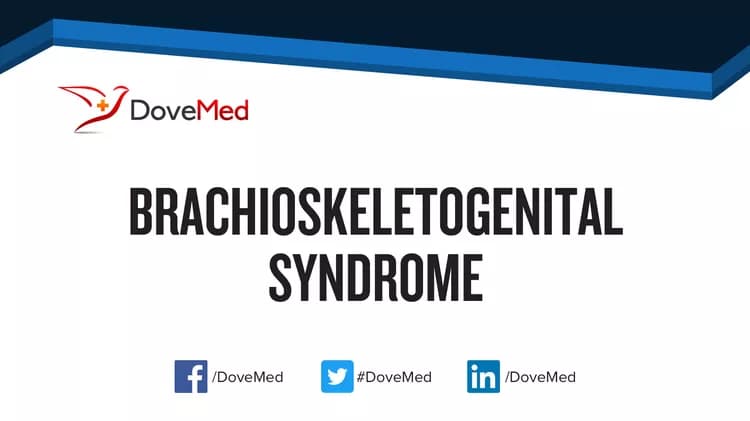What are the other Names for this Condition? (Also known as/Synonyms)
- Branchio-Skeleto-Genital Syndrome
- BSG syndrome
- Elsahy-Waters Syndrome
What is Brachioskeletogenital Syndrome? (Definition/Background Information)
- Branchio-Skeleto-Genital (BSG) Syndrome is an extremely rare multiple congenital anomalies/dysmorphic syndrome, described in three boys from one family
- It is characterized by intellectual disability, hypertelorism, broad and flat nasal bridge, maxillary hypoplasia, mandibular prognathism, bifid uvula or partial cleft palate, multiple dental cysts, Schmorl nodes, fused cervical spinous processes, pectus excavatum, and penoscrotal hypospadias
- There have been no further descriptions in the literature since 1971
(Source: Brachioskeletogenital Syndrome; Orphanet, National Institute of Health and Medical Research (INSERM), Paris.)
Who gets Brachioskeletogenital Syndrome? (Age and Sex Distribution)
- Brachioskeletogenital Syndrome is an extremely rare congenital disorder. The presentation of symptoms may occur at birth
- Both males and females may be affected. However, presently, all known cases have been described in males
- Worldwide, individuals of all racial and ethnic groups may be affected
What are the Risk Factors for Brachioskeletogenital Syndrome? (Predisposing Factors)
- Currently, no risk factors have been clearly identified for Brachioskeletogenital Syndrome
It is important to note that having a risk factor does not mean that one will get the condition. A risk factor increases one’s chances of getting a condition compared to an individual without the risk factors. Some risk factors are more important than others.
Also, not having a risk factor does not mean that an individual will not get the condition. It is always important to discuss the effect of risk factors with your healthcare provider.
What are the Causes of Brachioskeletogenital Syndrome? (Etiology)
The exact cause of development of Brachioskeletogenital Syndrome is presently unknown.
What are the Signs and Symptoms of Brachioskeletogenital Syndrome?
The signs and symptoms of Brachioskeletogenital Syndrome may include:
- Abnormality of the vertebral column
- Intellectual disability
- Wide nasal bridge
Based on the frequency of symptoms observed, the following information may be noted:
Very frequently present symptoms in 80-99% of the cases:
- Abnormality of dentin
- Abnormality of the sella turcica
- Abnormality of the shape of the midface
- Abnormality of the vertebral spinous processes
- Advanced pneumatization of the mastoid process
- Attached earlobe
- Bifid uvula
- Blepharochalasis
- Brachycephaly
- Broad nasal tip
- Carious teeth
- Downturned corners of mouth
- Flat face
- High forehead
- Highly arched eyebrow
- Hypertelorism
- Hypoplasia of the maxilla
- Intellectual disability, moderate
- Large earlobe
- Microcephaly
- Micropenis
- Pectus excavatum
- Penoscrotal hypospadias
- Periorbital wrinkles
- Pointed chin
- Proptosis
- Rootless teeth
- Short neck
- Strabismus
- Submucous cleft hard palate
- Synophrys
- Telecanthus
- Unilateral cleft palate
Frequently present symptoms in 30-79% of the cases:
- Downslanted palpebral fissures
- Mixed hearing impairment
- Premature loss of teeth
- Short philtrum
- Thin vermilion border
- Thoracolumbar kyphoscoliosis
Occasionally present symptoms in 5-29% of the cases:
- Cleft eyelid
- Seizures
- Ureteral stenosis
Very rarely present symptoms in 1-4% of the cases:
- Absent external genitalia
- Absent nipple
- Amelia involving the lower limbs
- Anteriorly placed anus
- Bladder exstrophy
- Umbilical hernia
- Upper limb peromelia
(Source: Brachioskeletogenital Syndrome; Genetic and Rare Diseases Information Center (GARD) of National Center for Advancing Translational Sciences (NCATS), USA.)
How is Brachioskeletogenital Syndrome Diagnosed?
Brachioskeletogenital Syndrome is diagnosed on the basis of the following information:
- Complete physical examination
- Thorough medical history evaluation
- Assessment of signs and symptoms
- Laboratory tests
- Imaging studies
- Biopsy studies, if necessary
Many clinical conditions may have similar signs and symptoms. Your healthcare provider may perform additional tests to rule out other clinical conditions to arrive at a definitive diagnosis.
What are the possible Complications of Brachioskeletogenital Syndrome?
The complications of Brachioskeletogenital Syndrome may include:
- Infertility
- Intellectual impairment
- Decreased quality of life
Complications may occur with or without treatment, and in some cases, due to treatment also.
How is Brachioskeletogenital Syndrome Treated?
Presently, there is no cure for Brachioskeletogenital Syndrome. The treatment is usually given to manage the signs and symptoms and any complications that develop.
How can Brachioskeletogenital Syndrome be Prevented?
- Currently, Brachioskeletogenital Syndrome may not be preventable, since the cause of this disorder is unknown
- Regular medical screening at periodic intervals with tests and physical examinations are recommended
What is the Prognosis of Brachioskeletogenital Syndrome? (Outcomes/Resolutions)
- The prognosis of Brachioskeletogenital Syndrome is dependent upon the severity of the signs and symptoms and associated complications, if any
- Individuals with mild conditions have better prognosis than those with severe symptoms and complications
- Typically, the prognosis may be assessed on a case-by-case basis
Additional and Relevant Useful Information for Brachioskeletogenital Syndrome:
The following DoveMed website link is a useful resource for additional information:
Related Articles
Test Your Knowledge
Asked by users
Related Centers
Related Specialties
Related Physicians
Related Procedures
Related Resources
Join DoveHubs
and connect with fellow professionals


0 Comments
Please log in to post a comment.